四年级新标准英语外研版上册教案
- 格式:doc
- 大小:256.00 KB
- 文档页数:39
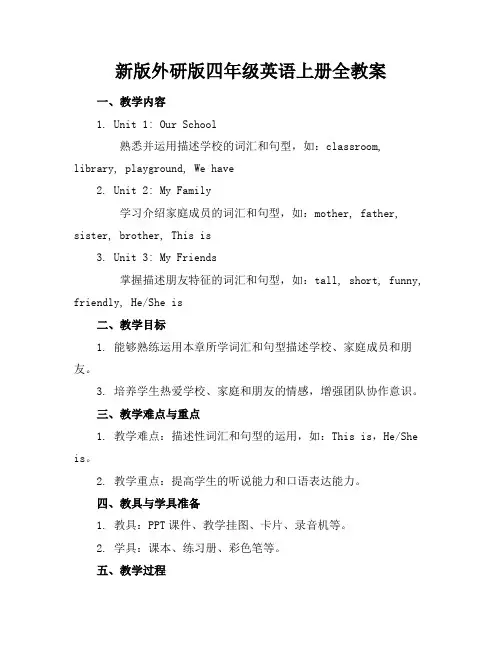
新版外研版四年级英语上册全教案一、教学内容1. Unit 1: Our School熟悉并运用描述学校的词汇和句型,如:classroom, library, playground, We have2. Unit 2: My Family学习介绍家庭成员的词汇和句型,如:mother, father, sister, brother, This is3. Unit 3: My Friends掌握描述朋友特征的词汇和句型,如:tall, short, funny, friendly, He/She is二、教学目标1. 能够熟练运用本章所学词汇和句型描述学校、家庭成员和朋友。
3. 培养学生热爱学校、家庭和朋友的情感,增强团队协作意识。
三、教学难点与重点1. 教学难点:描述性词汇和句型的运用,如:This is,He/She is。
2. 教学重点:提高学生的听说能力和口语表达能力。
四、教具与学具准备1. 教具:PPT课件、教学挂图、卡片、录音机等。
2. 学具:课本、练习册、彩色笔等。
五、教学过程1. 导入:通过PPT展示学校、家庭和朋友的照片,引导学生进行讨论,激发学习兴趣。
2. 新课内容展示:讲解本章重点词汇和句型,配以实例和图片,让学生理解并模仿。
3. 例题讲解:针对难点,设计相关例题,引导学生分析和解答。
4. 随堂练习:组织学生进行小组讨论,运用所学词汇和句型进行口语练习。
六、板书设计1. Unit 132. 重点词汇:classroom, library, playground, mother, father, sister, brother, tall, short, funny, friendly3. 重点句型:We have, This is, He/She is七、作业设计1. 作业题目:a. 描述你的学校,至少使用5个本章所学词汇。
b. 介绍你的家庭成员,使用本章所学句型。
c. 描述你的一个朋友,至少使用3个本章所学描述性词汇。
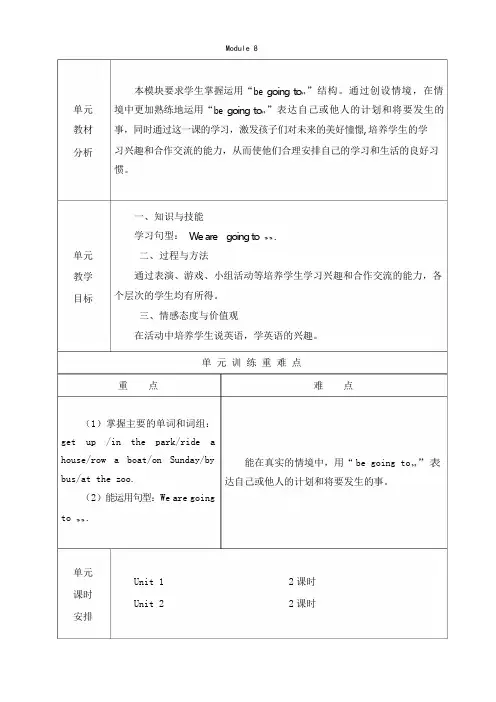
单元教材分析Module8本模块要求学生掌握运用“be going to…”结构。
通过创设情境,在情境中更加熟练地运用“be going to…”表达自己或他人的计划和将要发生的事,同时通过这一课的学习,激发孩子们对未来的美好憧憬,培养学生的学习兴趣和合作交流的能力,从而使他们合理安排自己的学习和生活的良好习惯。
单元教学目标一、知识与技能学习句型:W e are going to….二、过程与方法通过表演、游戏、小组活动等培养学生学习兴趣和合作交流的能力,各个层次的学生均有所得。
三、情感态度与价值观在活动中培养学生说英语,学英语的兴趣。
单元训练重难点重点(1)掌握主要的单词和词组:get up/in the park/ride a house/row a boat/on Sunday/by bus/at the zoo.(2)能运用句型:We are going to….难点能在真实的情境中,用“be going to…”表达自己或他人的计划和将要发生的事。
单元课时安排Unit12课时Unit22课时第一课时课题授课班级Unit1We are going to visit Hainan.四年级授课人主备人授课时间许淑芳教学目标教学重点教学难点教学准备课时安排一、知识与技能1.能听懂,会说日常交际用语:We are going to….2.能听懂,会说get up/in the park/ride a house/row a boat/on Sunday/by bus/at the zoo等词。
二、过程与方法1.在创设情景中,能使用句型We are going to…进行交流。
2.培养学生在游戏中熟练运用功能句型和词组的能力,在情境中灵活运用交际用语的能力和知识迁移的能力。
三、情感态度与价值观1.在教学游戏中学会交际,学会鼓励他人,学会欣赏和赞赏他人。
2.培养学生的团队意识和合作精神,共同完成学习任务。
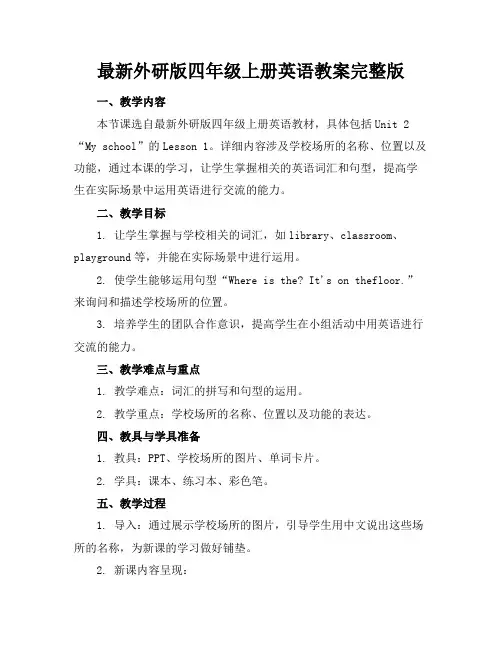
最新外研版四年级上册英语教案完整版一、教学内容本节课选自最新外研版四年级上册英语教材,具体包括Unit 2 “My school”的Lesson 1。
详细内容涉及学校场所的名称、位置以及功能,通过本课的学习,让学生掌握相关的英语词汇和句型,提高学生在实际场景中运用英语进行交流的能力。
二、教学目标1. 让学生掌握与学校相关的词汇,如library、classroom、playground等,并能在实际场景中进行运用。
2. 使学生能够运用句型“Where is the? It's on thefloor.”来询问和描述学校场所的位置。
3. 培养学生的团队合作意识,提高学生在小组活动中用英语进行交流的能力。
三、教学难点与重点1. 教学难点:词汇的拼写和句型的运用。
2. 教学重点:学校场所的名称、位置以及功能的表达。
四、教具与学具准备1. 教具:PPT、学校场所的图片、单词卡片。
2. 学具:课本、练习本、彩色笔。
五、教学过程1. 导入:通过展示学校场所的图片,引导学生用中文说出这些场所的名称,为新课的学习做好铺垫。
2. 新课内容呈现:a. 教师展示PPT,呈现学校场所的图片,引导学生用英文说出场所名称,学习新词汇。
b. 教师引导学生用句型“Where is the? It's on thefloor.”来询问和描述场所的位置。
c. 教师组织学生进行角色扮演,巩固所学词汇和句型。
3. 随堂练习:学生完成教材中的Activity 1和Activity 2,巩固所学知识。
4. 小组活动:学生分成小组,用所学词汇和句型设计一个学校的平面图,并进行介绍。
六、板书设计1. 主要词汇:library、classroom、playground、office、first floor、second floor等。
2. 主要句型:Where is the? It's on thefloor.七、作业设计1. 作业题目:绘制一幅学校的平面图,并用英文标注场所名称和位置。
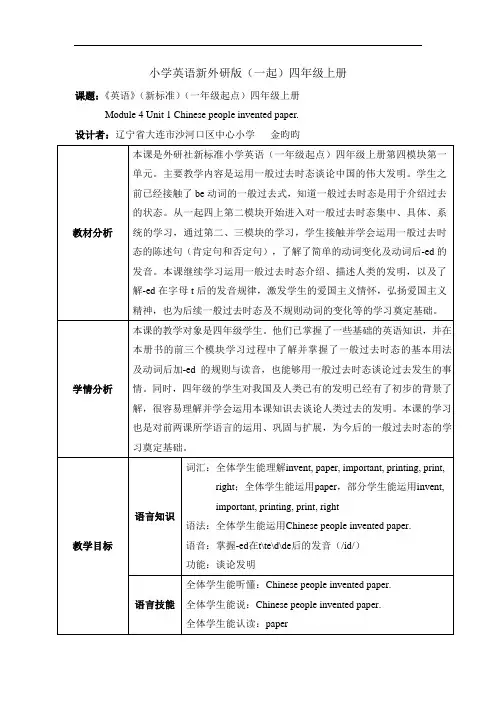
小学英语新外研版(一起)四年级上册课题:《英语》(新标准)(一年级起点)四年级上册
Module 4 Unit 1 Chinese people invented paper.
设计者:辽宁省大连市沙河口区中心小学金昀昀
2.(拓展训练)这些发明你知道吗?
教师出示“电话、收音机和篮球”这些贴近学生生活的
图片,并提问“你知道是谁(哪国人)发明的吗?”
PPT第27页
小结
与
布置作业(2分钟)1.小结
T: Now let’s look at the blackboard, what did we learn
today?
教师引导学生总结本课所学目标语句、词语及用法。
2. 布置分层作业,学生自主选做。
套餐A:抄写词汇、语句各4个;跟读课文2遍;
收集外国人的发明。
套餐B:抄写词汇、语句各2个;自读课文2遍;
收集外国人的发明。
套餐C:在本上写出你所喜欢的两种中国发明;
背诵课文;收集外国人的发明。
PPT第28页。
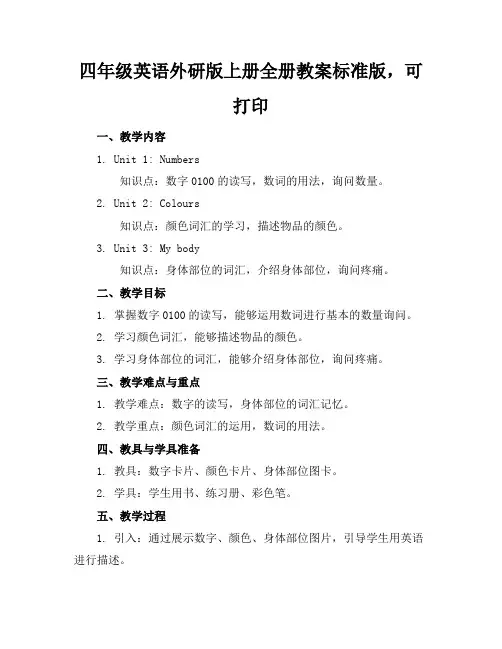
四年级英语外研版上册全册教案标准版,可打印一、教学内容1. Unit 1: Numbers知识点:数字0100的读写,数词的用法,询问数量。
2. Unit 2: Colours知识点:颜色词汇的学习,描述物品的颜色。
3. Unit 3: My body知识点:身体部位的词汇,介绍身体部位,询问疼痛。
二、教学目标1. 掌握数字0100的读写,能够运用数词进行基本的数量询问。
2. 学习颜色词汇,能够描述物品的颜色。
3. 学习身体部位的词汇,能够介绍身体部位,询问疼痛。
三、教学难点与重点1. 教学难点:数字的读写,身体部位的词汇记忆。
2. 教学重点:颜色词汇的运用,数词的用法。
四、教具与学具准备1. 教具:数字卡片、颜色卡片、身体部位图卡。
2. 学具:学生用书、练习册、彩色笔。
五、教学过程1. 引入:通过展示数字、颜色、身体部位图片,引导学生用英语进行描述。
2. 例题讲解:展示数字图片,教授数字的读写,引导学生进行数词的运用。
展示颜色图片,教授颜色词汇,引导学生进行颜色描述。
展示身体部位图片,教授身体部位词汇,引导学生进行身体部位的介绍和询问疼痛。
3. 随堂练习:分组进行数字、颜色、身体部位的描述和问答练习。
六、板书设计1. 数字0100的读写。
2. 颜色词汇表。
3. 身体部位词汇表。
七、作业设计1. 作业题目:写出数字0100。
用英语描述自己穿的衣服颜色。
介绍自己的身体部位,并询问同桌的疼痛情况。
2. 答案:八、课后反思及拓展延伸1. 教师反思:关注学生对数字、颜色、身体部位词汇的掌握程度,针对学生薄弱环节进行针对性教学。
2. 拓展延伸:设计数字接龙游戏,加强学生对数字的读写能力。
开展颜色主题绘画活动,让学生在实际操作中运用颜色词汇。
举办身体部位健康知识讲座,拓展学生的知识面。
重点和难点解析1. 教学难点的突破方法。
2. 教学重点的巩固策略。
3. 作业设计的针对性与实践性。
4. 课后反思与拓展延伸的实际操作。
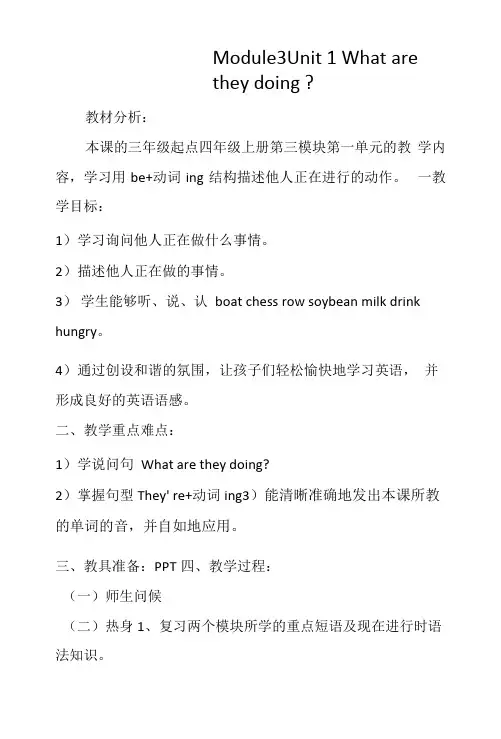
Module3Unit 1 What arethey doing ?教材分析:本课的三年级起点四年级上册第三模块第一单元的教学内容,学习用be+动词ing结构描述他人正在进行的动作。
一教学目标:1)学习询问他人正在做什么事情。
2)描述他人正在做的事情。
3)学生能够听、说、认boat chess row soybean milk drink hungry。
4)通过创设和谐的氛围,让孩子们轻松愉快地学习英语,并形成良好的英语语感。
二、教学重点难点:1)学说问句What are they doing?2)掌握句型They' re+动词ing3)能清晰准确地发出本课所教的单词的音,并自如地应用。
三、教具准备:PPT四、教学过程:(一)师生问候(二)热身1、复习两个模块所学的重点短语及现在进行时语法知识。
2、复习be动词的使用。
(三)新课教学1、出示打太极拳的图片,教授短语dotaijiquan.2、教学do taijiquan•的ing 形式doing taijiquan3、引导学生说:“They are doing taijiquan.”板书句子,并抽学生朗读句子。
4、以这样的方式教学以下句子:(1) They are rowing a dragon boat.(2)They are playing chess.(3)They are drinking soya milk5、出示图片,教授单词hungry及句子『m hungry.6、操练(1)课件出示本节课所学短语,请学生说出短语的意思,并分组朗读。
(2)出示图片,请学生用句型What are they doingPThey're .….进行对话操练。
抽学生展示。
(3)带领学生完课堂活动书上的练习题。
7、家庭作业收集有关人物或动物正在进行某种动作行为的照片、图片、图案,并用英语说说他们正在做什么?。
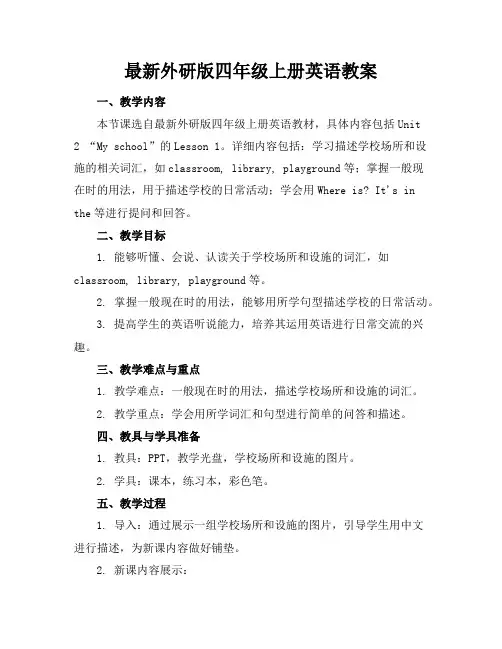
最新外研版四年级上册英语教案一、教学内容本节课选自最新外研版四年级上册英语教材,具体内容包括Unit2 “My school”的Lesson 1。
详细内容包括:学习描述学校场所和设施的相关词汇,如classroom, library, playground等;掌握一般现在时的用法,用于描述学校的日常活动;学会用Where is? It's in the等进行提问和回答。
二、教学目标1. 能够听懂、会说、认读关于学校场所和设施的词汇,如classroom, library, playground等。
2. 掌握一般现在时的用法,能够用所学句型描述学校的日常活动。
3. 提高学生的英语听说能力,培养其运用英语进行日常交流的兴趣。
三、教学难点与重点1. 教学难点:一般现在时的用法,描述学校场所和设施的词汇。
2. 教学重点:学会用所学词汇和句型进行简单的问答和描述。
四、教具与学具准备1. 教具:PPT,教学光盘,学校场所和设施的图片。
2. 学具:课本,练习本,彩色笔。
五、教学过程1. 导入:通过展示一组学校场所和设施的图片,引导学生用中文进行描述,为新课内容做好铺垫。
2. 新课内容展示:a. 播放教学光盘,让学生听、跟读新词汇。
b. 教师用PPT展示词汇卡片,引导学生认读词汇。
c. 教师创设情境,用一般现在时描述学校的日常活动,引导学生模仿。
3. 实践活动:a. 学生两人一组,用所学词汇和句型进行问答练习。
b. 教师随机抽取学生进行展示,给予鼓励和评价。
4. 例题讲解:讲解一般现在时的用法,结合例题进行讲解。
5. 随堂练习:学生完成课本上的练习题,巩固所学内容。
六、板书设计1. Unit 2 My school2. 内容:a. 词汇:classroom, library, playground等。
b. 句型:Where is? It's in the; What do you do in? I七、作业设计1. 作业题目:a. 用一般现在时描述你最喜欢的学校场所及其活动。
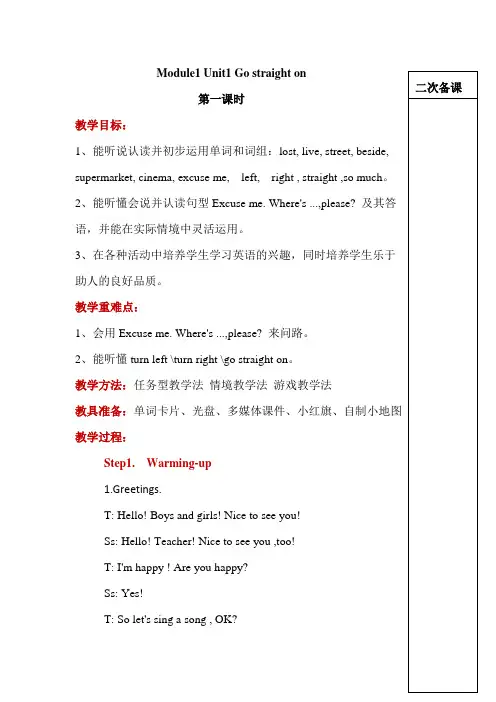
Module1 Unit1 Go straight on Array第一课时教学目标:1、能听说认读并初步运用单词和词组:lost, live, street, beside,supermarket, cinema, excuse me, left, right , straight ,so much。
2、能听懂会说并认读句型Excuse me. Where's ...,please? 及其答语,并能在实际情境中灵活运用。
3、在各种活动中培养学生学习英语的兴趣,同时培养学生乐于助人的良好品质。
教学重难点:1、会用Excuse me. Where's ...,please? 来问路。
2、能听懂turn left \turn right \go straight on。
教学方法:任务型教学法情境教学法游戏教学法教具准备:单词卡片、光盘、多媒体课件、小红旗、自制小地图教学过程:Step1. Warming-up1.Greetings.T: Hello! Boys and girls! Nice to see you!Ss: Hello! Teacher! Nice to see you ,too!T: I'm happy ! Are you happy?Ss: Yes!T: So let's sing a song , OK?2.教师出示课件,播放兔子舞,让学生跟唱,跟着跳。
二次备课3.师生一起做功夫操,复习巩固方位词:on/ in/under /behind/near/...Step2. Presentation1.Lead–in(1)(播放光盘)Listen to the chant of part 1。
教师利用PPT出示Tom and Sam捉迷藏的图片,T: Thischant is about Tom and Sam . Look! They are playinghide and seek. me. Where is Tom now?(同时板书句型Excuse me. Where is...?) Ss:(引导学生回答)on the right/left.(2)(出示单词卡片)Teaching the two words : left /Right T:“l ”says/l/,“e ”says/e/,“f ”says/f/,“t ”says/t/----left. Group A---left. GroupB---left. .... (引导学生使用自然拼读的方式学习新单词)2.(出示课件)课件出示part2主题图,picture talking:T:Look at Picture .Who are they?S1:They are Sam and Amy.T:Yes. They find a dog on the street. But what'swrong with the dog? Please read the dialogue quicklyand find the answer. (让学生自由阅读对话并找出答案)3.邀请学生回答问题,并教授新单词lost。
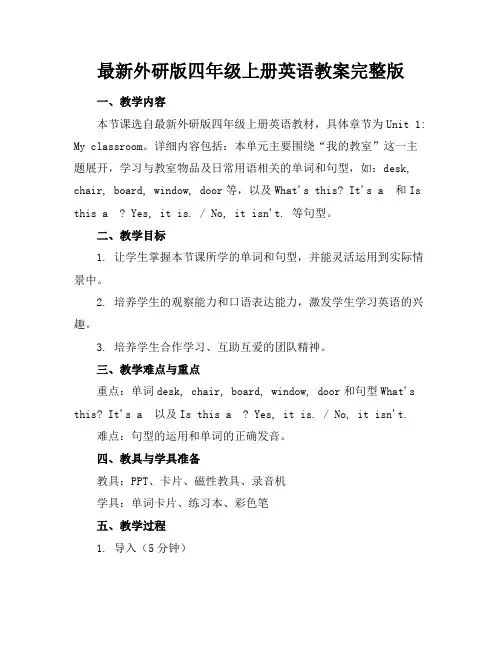
最新外研版四年级上册英语教案完整版一、教学内容本节课选自最新外研版四年级上册英语教材,具体章节为Unit 1: My classroom。
详细内容包括:本单元主要围绕“我的教室”这一主题展开,学习与教室物品及日常用语相关的单词和句型,如:desk, chair, board, window, door等,以及What's this? It's a 和Is this a ? Yes, it is. / No, it isn't. 等句型。
二、教学目标1. 让学生掌握本节课所学的单词和句型,并能灵活运用到实际情景中。
2. 培养学生的观察能力和口语表达能力,激发学生学习英语的兴趣。
3. 培养学生合作学习、互助互爱的团队精神。
三、教学难点与重点重点:单词desk, chair, board, window, door和句型What's this? It's a 以及Is this a ? Yes, it is. / No, it isn't.难点:句型的运用和单词的正确发音。
四、教具与学具准备教具:PPT、卡片、磁性教具、录音机学具:单词卡片、练习本、彩色笔五、教学过程1. 导入(5分钟)教师展示一幅教室图片,引导学生观察并描述教室里的物品。
学生用中文描述,教师将其翻译成英文,如:This is a desk. This is a chair.2. 新课展示(15分钟)教师展示PPT,教授单词desk, chair, board, window, door,并让学生跟读。
教师用磁性教具展示句型What's this? It's a 和Is thisa ? Yes, it is. / No, it isn't.,并结合图片进行讲解。
3. 例题讲解(10分钟)教师展示例题,如:What's this? It's a desk. Is this a chair? No, it isn't.教师引导学生进行替换练习,巩固句型。
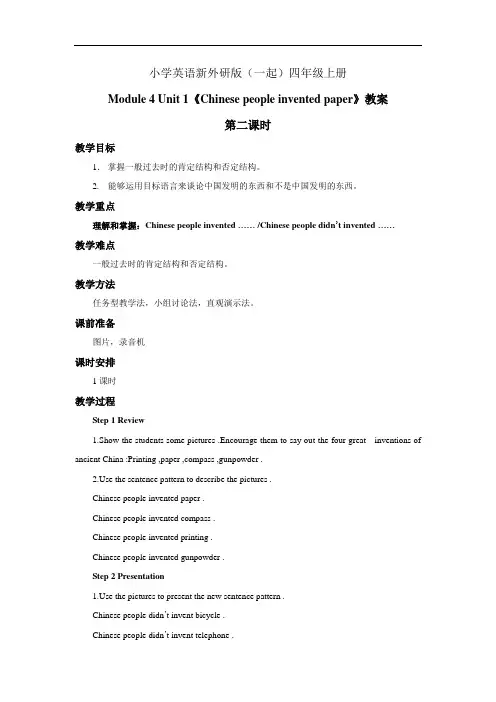
小学英语新外研版(一起)四年级上册Module 4 Unit 1《Chinese people invented paper》教案第二课时教学目标1.掌握一般过去时的肯定结构和否定结构。
2. 能够运用目标语言来谈论中国发明的东西和不是中国发明的东西。
教学重点理解和掌握:Chinese people invented …… /Chinese people didn’t invented ……教学难点一般过去时的肯定结构和否定结构。
教学方法任务型教学法,小组讨论法,直观演示法。
课前准备图片,录音机课时安排1课时教学过程Step 1 Review1.Show the students some pictures .Encourage them to say out the four great inventions of ancient China :Printing ,paper ,compass ,gunpowder .e the sentence pattern to describe the pictures .Chinese people invented paper .Chinese people invented compass .Chinese people invented printing .Chinese people invented gunpowder .Step 2 Presentatione the pictures to present the new sentence pattern .Chinese people didn’t invent bicycle .Chinese people didn’t invent telephone .Chinese people didn’t invent plane .Chinese people didn’t invent computer .1.Help the students summarize the sentence pattern :主语+didn’t+动词原形+其他。
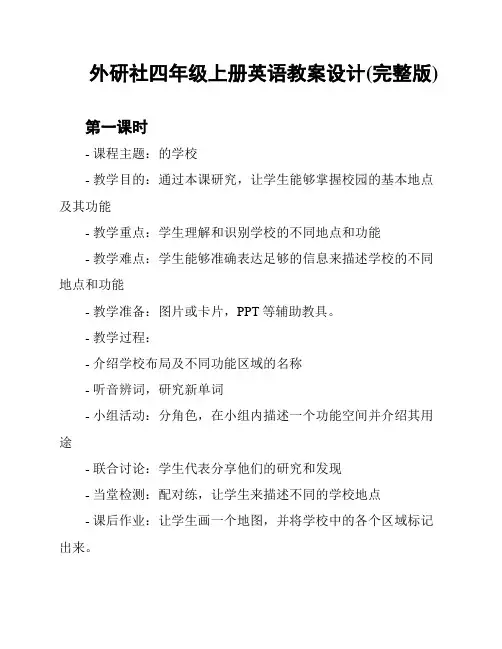
外研社四年级上册英语教案设计(完整版)第一课时- 课程主题:的学校- 教学目的:通过本课研究,让学生能够掌握校园的基本地点及其功能- 教学重点:学生理解和识别学校的不同地点和功能- 教学难点:学生能够准确表达足够的信息来描述学校的不同地点和功能- 教学准备:图片或卡片,PPT等辅助教具。
- 教学过程:- 介绍学校布局及不同功能区域的名称- 听音辨词,研究新单词- 小组活动:分角色,在小组内描述一个功能空间并介绍其用途- 联合讨论:学生代表分享他们的研究和发现- 当堂检测:配对练,让学生来描述不同的学校地点- 课后作业:让学生画一个地图,并将学校中的各个区域标记出来。
第二课时- 课程主题:我的新老师- 教学目的:让学生能够根据姓名和职业对老师进行介绍- 教学重点:学生理解一些基本的职业单词和形容词- 教学难点:学生掌握合适的单词表达和语法建构- 教学准备:图片或卡片,PPT等辅助教具。
- 教学过程:- 热身:老师介绍自己并向学生问好。
并通过复第一节课中学到的知识对学生进行提问,以复校园地点和功能。
- 聆听和搜集:让学生聆听老师简短的自我介绍。
然后让学生听同学进行介绍,记录你对每位老师的了解。
- 与他人交流:让学生向其他学生介绍新老师,并分享自己的观察和搜集到的新信息。
这将是一个集体讨论的机会,帮助学生表达和分享他们听到的信息。
- 部署任务:教师提醒学生记录学生的反馈和如何更好地传达信息。
- 当堂检测:分角色,让学生互相介绍这些老师。
- 课后作业:用更完整的方式介绍他们的班主任或另一个新老师,用1分钟的时间介绍一下他们。
第三课时- 课程主题:我的家乡- 教学目的:通过英语课程了解地理概念、社区和家庭,以解决日常问题。
- 教学重点:学生理解基本的家庭、社区和地理术语。
- 教学难点:学生学会如何用英语介绍家庭和家乡。
- 教学准备:图片或卡片,PPT等辅助教具。
- 教学过程:- 讨论发问:讨论各个同学的家乡,并向学生提供解释他们家乡的文化和历史的机会。
新版外研版四年级英语上册全教案一、教学内容1. Unit 1: Back to School知识点:学校场所词汇、一般现在时、自我介绍课文:1a1f2. Unit 2: My Friends知识点:人物描述词汇、一般现在时、描述朋友课文:2a2f二、教学目标1. 掌握本单元涉及的词汇和句型,能够运用一般现在时描述学校和朋友的情景。
2. 能够进行简单的自我介绍和描述他人,培养口语表达能力。
3. 提高学生的听力水平,使他们能够理解并获取课文中的关键信息。
三、教学难点与重点1. 教学难点:一般现在时态的运用,人物描述词汇的运用。
2. 教学重点:学校场所词汇、描述朋友、自我介绍。
四、教具与学具准备1. 教具:PPT、卡片、磁铁、录音机、教材。
2. 学具:练习本、彩笔、教材。
五、教学过程1. 导入:通过展示学校图片,引导学生用英语描述学校场所,复习Unit 1的词汇。
2. 课文学习:a. 听力练习:播放课文录音,让学生跟读,提高听力水平。
b. 词汇学习:学习Unit 1和Unit 2的人物描述词汇,用一般现在时进行描述。
c. 例题讲解:讲解一般现在时的用法,举例说明。
d. 随堂练习:学生两人一组,进行自我介绍和描述朋友,教师巡回指导。
3. 口语练习:学生分组进行角色扮演,模拟真实场景进行对话。
4. 课后巩固:布置课后作业,进行课后复习。
六、板书设计1. 四年级英语上册教案2. 内容:a. Unit 1: Back to School词汇:school, classroom, library, playground,句型:I go to school every day. I have classes in the classroom.b. Unit 2: My Friends词汇:tall, short, fat, thin,句型:My friend is tall. He has short hair.七、作业设计1. 作业题目:a. 根据Unit 1的词汇,写一段关于学校的自我介绍。
小学英语新外研版(一起)四年级上册《英语》(新标准)一起第七册M3Module 3 Unite 1 She didn’t walk to school yesterday.一、教学目标与要求:1、知识与能力目标:本模块主要讲授的是实义动词的一般过去式的否定形式“didn’t”的用法。
在第一单元中通过运用一般现在时对Lingling生活习惯的描述以及实义动词一般过去时的否定形式对于过去某一天没有发生的活动的描述来进行对比,帮助学生理解否定式的含义及用法。
在第二单元中通过阅读、歌曲及游戏等活动来进一步复习和巩固第一单元中所呈现的重点语言知识。
2、情感态度目标:以National Day为契机,培养学生热爱祖国、热爱家乡的美好情感。
二、教学重点及难点:能通过练习、运用等活动使学生能够掌握一般过去式及其实义动词一般过去式否定形式的用法是本模块的重点。
本模块涉及到的语法项目比较多,有一般现在时及其第三人称单数、一般过去式及实义动词的否定式。
使学生能正确的运用进行语言的交际是本模块的难点。
三、课前准备:录音机、磁带、单词卡片、VCD四、教学过程Step1 Warm—up1 I do you say.老师做动作,学生用”You _______yesterday.”来描述老师昨天做过的事情.2 Free talk:T: “When do you usually get up? /How do you usually go to school?”(复习usually 的用法)Step2 Presentation and practice:1指导学生询问老师的一些情况.老师就自己的情况做出回答,如:“I usually get up at 6.But I didn’t get up at 6 yesterday.”让学生初步了解“didn’t”的意思。
2、T:“lingling usually gets up at 6:30.But she didn’t get up at 6 :30yesterday,either.”可让学生猜一下没在6点半起床的原因。
新版外研版四年级英语上册全教案一、教学内容Unit 1: Our SchoolLesson 1: What’s in our school?Lesson 2: What subjects do you like?Unit 2: My FriendsLesson 3: Who are your friends?Lesson 4: What do your friends look like?二、教学目标1. 让学生掌握描述学校设施和课程的基础词汇和句型。
2. 培养学生用英语描述朋友外貌和性格特征的能力。
3. 提高学生的听说读写技能,增强他们运用英语进行日常交流的自信心。
三、教学难点与重点教学难点:对不同科目和学校设施的词汇掌握。
使用正确时态描述朋友外貌和性格。
教学重点:掌握和运用描述学校和朋友的相关词汇。
使用一般现在时描述常态。
四、教具与学具准备教师准备:PPT展示学校设施和课程图片,朋友外貌描述卡片。
学生准备:英语课本、练习本、彩色笔。
五、教学过程1. 实践情景引入(10分钟)展示学校图片,引导学生讨论学校里的设施。
使用“What’s in our school?”提问,让学生回答。
2. 新课内容展示(15分钟)通过PPT展示不同科目,教授相关词汇(maths, Chinese, English, music, art)。
学生跟读并模仿,进行小组活动,用新学词汇进行交流。
3. 例题讲解(10分钟)通过Lesson 2中的例句,讲解一般现在时态,并让学生模仿造句。
展示朋友外貌描述卡片,教授描述外貌的词汇(tall, short, fat, thin, funny)。
4. 随堂练习(15分钟)学生两人一组,用新学词汇描述学校和朋友,进行角色扮演。
教师巡回指导,纠正发音和语法错误。
5. 互动游戏(10分钟)进行“Who am I?”游戏,学生用描述外貌的词汇猜测对方扮演的同学。
六、板书设计课程名称和单元。
新版外研版四年级英语上册全教案一、教学内容Unit 1: Back to SchoolLesson 1: What's in your bag?Lesson 2: How many books do you have?Unit 2: My FriendsLesson 3: Who's your friend?Lesson 4: He's cool.二、教学目标1. 让学生掌握本单元的词汇和句型,能够运用到实际生活中。
2. 培养学生的听说能力和团队合作精神。
3. 引导学生学会描述人物特征和物品数量。
三、教学难点与重点1. 教学难点:描述人物特征和物品数量的句型运用。
2. 教学重点:词汇的识记和听说能力的培养。
四、教具与学具准备1. 教具:PPT课件、卡片、录音机、磁带。
2. 学具:英语课本、练习本、彩色笔。
五、教学过程1. 导入:通过歌曲《Hello, Hello, Hello!》带领学生进入英语课堂氛围。
2. 环节一:展示PPT课件,引导学生学习Unit 1的词汇和句型。
a. 播放录音,让学生跟读。
b. 教师带领学生进行角色扮演,练习句型。
3. 环节二:实践情景引入,让学生分组讨论,用所学词汇和句型进行对话。
4. 环节三:例题讲解,针对Unit 2的词汇和句型进行讲解。
5. 环节四:随堂练习,让学生完成练习册的相关练习。
六、板书设计1. Unit 1: Back to SchoolWhat's in your bag? My bag hasHow many books do you have? I have2. Unit 2: My FriendsWho's your friend? My friend isHe's cool.七、作业设计1. 作业题目:a. 根据所学内容,编写一段对话,描述你的书包和书。
b. 描述一位你的朋友,包括他的外貌和性格特点。
最新外研版四年级上册英语教案一、教学内容本节课选自最新外研版四年级上册英语教材,具体章节为Unit 2 "My schoolbag"。
教学内容详细包括:单词学习(如:textbook, schoolbag, pencil, pen等),句型练习(如:What's in your schoolbag? It's),以及日常对话的练习。
二、教学目标1. 学生能够听懂、准确说出与学校生活相关的单词和句型。
2. 学生能够在实际情景中运用所学单词和句型进行简单对话。
3. 培养学生的观察能力和合作精神,提高学习英语的兴趣。
三、教学难点与重点教学难点:单词的准确发音和句型的正确运用。
教学重点:掌握本节课的单词和句型,并能用于实际情景。
四、教具与学具准备教师准备:教材、教学课件、卡片、录音机等。
学生准备:课本、练习本、彩色笔等。
五、教学过程1. 导入(5分钟)利用图片和实物展示学校生活常见的物品,引导学生用英语进行描述。
以小组竞赛的形式,让学生说出与学校生活相关的单词。
2. 新课内容呈现(15分钟)通过教材中的插图,引导学生学习新单词和句型。
教师示范句型和单词的正确发音,学生跟读并模仿。
3. 实践活动(10分钟)学生分组进行角色扮演,运用所学单词和句型进行对话练习。
教师巡回指导,纠正发音和语法错误。
4. 例题讲解与随堂练习(10分钟)教师展示例题,引导学生运用所学知识解决问题。
学生独立完成随堂练习,教师点评并解答疑问。
教师带领学生回顾本节课所学内容,巩固记忆。
分组讨论:如何用所学英语描述自己的书包。
六、板书设计板书内容包括:本节课的单词、句型,以及重点语法。
设计简洁明了,突出重点。
七、作业设计1. 作业题目:用英语描述自己的书包,并写一篇小短文。
答案示例:My schoolbag is blue. There are many thingsin it, such as textbooks, pencils, pens and so on. I like my schoolbag very much.2. 课后练习:完成教材中的练习题。
Module 1 Unit 1 Go straight on. 第一课时
【教学目标】: 知识与技能: ---Where ' s the … please? ---Go straight on.\Turn left.\Turn right. road supermarket hill house station 过程与方法: 1 Review the words about directions by game method. 2 Teach the text with the task-based method. 3 Do a survey by cooperative learning . 情感、态度和价值观:问路并能准确指明方向 【重点】:road supermarket hill house station 【难点】:---Where ' s the … please? ---Go straight on.\Turn left.\Turn right. 【教学方法】:讲授 【课时安排】:1课时 【教学过程】: (一)导入:登山比赛摘苹果:制作了各种动物卡片,把全班学生分成两个擂台组,每组选两名学生到黑板前,一个表演,一个说英语,用句型Have you got a tiger?Yes,I have.如果说对了,就登一个台阶。谁先登上山顶摘到苹果,即为本次擂台的擂主。 (设计说明:这样的游戏活动,通过小组合作与对等性的竞争,巩固了上一节课有关动物的单词,学生兴趣盎然。) (二)探究新知:1.导入新课 点击课件,多媒体显示Beijing tian”anmen的图片,告诉学生在北京我遇见一位外国人,用英语为他指路去天安门,我最棒。 Look at this picture,please.It is Beijing tiananmei.Beijing is very beautiful.Do you want to go?Class,I have been to Beijing.In Beijing,I met a foreigner.He did not know how to get to Beijing Tiananmen.I tell him the way.I am the best.Yes?In this class lets learn how to ask the way?点击课件,多媒体显示Ask the way.问路And lets learn how to point the way? 点击课件,多媒体显示Point the way.指路Now class if you learn very well,you are the best. 2.讲授新课 A.点击课件,多媒体显示狗的图片。Class,here is a dog .The dog is lost.lost the meaning :迷路。Nevermind,here is her address. 点击课件,多媒体显示狗的地址:My name is Doudou.I live in No.2 West Lake Road.接着用单词卡学习新单词live,road.如live:I live in Chengbei?Where do you live? B.Chant: 点击课件,多媒体显示Chant:Lost,lost,lost.The dog is lost. Live,live,live.I live in West Lake Road. (设计意图:通过韵律诗,操练单词lost,live,road。此时chant的运用使枯燥的机械操练变得不在单调和乏味。) C.Lets help Doudou to find her house.Ok? Lets ask the way:Excuse me.Where is No.2West Lake Road,please? 在次领读单词Excuse me,并举例:Excuse me.Where is the school/zoo/park,please? 点击课件,多媒体显示一个十字路口,随着多媒体的显示学习指路短语:go straight on,turn left,tyrn right.以及单词supermarket D.Game:拔河比赛 把全班学生分成两大组:left和right.游戏开始时,一组的学生喊:left;另一组的学生喊:right; E.Listen to the radio.Listen again and answer the questions. 点击课件,多媒体显示 Questions: 1).How is the dog? 2).Where does the dog live? 3).Where is the No.2 West Lake Road? 3.角色表演 教师把头饰交给学生,让他们分别扮演Sam,Amy,dog,the old man,the dogs owner. (设计意图:小学生想象力丰富,善于模仿,具有强烈的表现欲;教师让学生进行角色表演,可以调动学生的学习积极性,使学生主动参与教学活动,大胆地说和夸张地演。) 4.任务完成 (1)让学生到黑板前做指令性动作,练习go straight on,turn left,turn right. (2)根据图片1,2,3,小组合作问路,指路。 5.拓展新知 游戏:帮助盲人过马路。点击课件,多媒体播放《爱的奉献》。在背景音乐中帮助盲人过马路。点击课件,多媒体显示: Help people in trouble. Be full of love in world. (三)巩固新知:A 、游戏法区分 left/right 。问句“ Where ' s the … please? ”这一句子学生很快就能掌握,难点就在于学生能否灵活并准确的作答。对于表示方位的单词“ left ”“ right ”,学生最易混淆。那我们可将这两个单词放在一起比较练习。运用一些小游戏,例如: 1 )老师说单词,学生相应举起左手或右手。 2 )老师藏一只铅笔或其它东西在某一手中,问“ Where ' s the pencil? ”,让学生猜。 3 )带学生“开火车”跳兔子舞。 B 、贴图游戏:训练学生熟悉地名并巩固方向的表达。画条十字路,老师收纳几张表示地方的卡片,要学生帮忙贴到正确的位置。引导学生发问:“ Where is the … please? ”老师回答或请小老师来回答“ Go straight on. Turn left. It ' s on your right. ”然后选学生上台把图片贴在正确的位置上。可结合 P8 的活动 3 提供的小游戏进行进一步的巩固练习,如有时间,可以跟学生玩一玩 P9 活动 5 提供的小游戏: Listen and do, 寻找教室里的“宝藏”,在玩这个游戏的时候,我的学生们热情特别高,甚至不由自主地也当起了“指路员”,很快熟悉了这几个短语。 C 、课时安排。这个模块两个单元的教学,大概需要花费两个课时,而在第四个课时里,可以进行各种任务型游戏活动及儿歌的表演,如刚说的贴图游戏。 (四)作业布置: (五)小结:学会了方位短语,练习口语化交流 (六)板书设计: Module 2 Directions Unit 1 Go straight on Road supermarket hill house station ---Where ' s the … please? ---Go straight on.\Turn left.\Turn right.
Module 1 Unit 2 It’s at the station. 第二课时
【教学目标】: 知识与技能:the key words: up down near at 过程与方法:运用探究合作的学习方法,激发学生兴趣 情感、态度和价值观:培养学英语的兴趣 【重点】:the key words: up down near at 【难点】:正确使用方位介词描述简单的位置关系 【教学方法】:讲授、游戏 【课时安排】:1课时 【教学过程】: (一)导入: 1. Warm—up 当老师走进教室时,仍然利用第7页活动三来帮助同学们回顾所学的知识,大面积的提问同学,营造良好的英语氛围。 2. Leading-up 根据上节课布置的课后作业,点名部分同学或者小组进行展示,既可以复习所学知识,检查课后作业,又可以引出导入我们新课的教学。检查完毕后,教师说,Let’s listen to the tape, and find out where the train is. (二)探究新知:活动1 listen and point 1,播放录音,学生聆听, 录音, 学生聆听,并且找到所读句子。 学生自读课文, 播放录音,学生聆听,并且跟读。 学生自读课文 underline the key words: up down near at 学生互相检查朗读课文 活动3 在了解了活动的要求之后,给同学或者小组3-5分钟的时间进行准备,然后教师可以以小组积分的形式鼓励同学们积极发言。 活动4,poem previse listen and point again listen and sing along again listen and sing loudly and do some actions (三)巩固新知: 带学生“开火车”跳兔子舞。 贴图游戏:训练学生熟悉地名并巩固方向的表达。画条十字路,老师收纳几张表示地方的卡片,要学生帮忙贴到正确的位置。引导学生发问:“ Where is the … please? ”老师回答或请小老师来回答“ Go straight on. Turn left. It ' s on your right. ”然后选学生上台把图片贴在正确的位置上。可结合 P8 的活动 3 提供的小游戏进行进一步的巩固练习,如有时间,可以跟学生玩一玩 P9 活动 5 提供的小游戏: Listen and do, 寻找教室里的“宝藏”,在玩这个游戏的时候,我的学生们热情特别高,甚至不由自主地也当起了“指路员”,很快熟悉了这几个短语。 (四)作业布置: (五)小结:利用课文中的句子,解释指路和问路的过程当中应当注意的问题、常用的句型、以及礼貌用语等问题 (六)板书设计: Unit 2 It's at the station. road supermarket hill house station (七)课后反思: